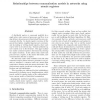Free Online Productivity Tools
i2Speak
i2Symbol
i2OCR
iTex2Img
iWeb2Print
iWeb2Shot
i2Type
iPdf2Split
iPdf2Merge
i2Bopomofo
i2Arabic
i2Style
i2Image
i2PDF
iLatex2Rtf
Sci2ools
IPPS
2006
IEEE
2006
IEEE
Relationships between communication models in networks using atomic registers
A distributed system is commonly modelled by a graph where nodes represent processors and there is an edge between two processors if and only if they can communicate directly. In shared-registers versions of this general description, neighbouring processors communicate by reading or writing shared registers, where each read or write is one atomic step. Variants of shared register models occur in the literature. This paper de
ned two models of shared registers determined by selecting the register locations. In the atomic-state model each processor has a register; in the atomic-link model, each communication link has a register. We determine under what conditions and with what robustness and/or failure-tolerance guarantees it is possible to transform a solution under the atomic-state model into a solution under the atomic-link model. The fault-tolerant models considered in this paper are waitfreedom and self-stabilization. These questions are addressed by
rst establishing a framework f...
Atomic-state Model | Distributed And Parallel Computing | IPPS 2006 | Nodes Represent Processors | Register Models |
| Added | 12 Jun 2010 |
| Updated | 12 Jun 2010 |
| Type | Conference |
| Year | 2006 |
| Where | IPPS |
| Authors | Lisa Higham, Colette Johnen |
Comments (0)

